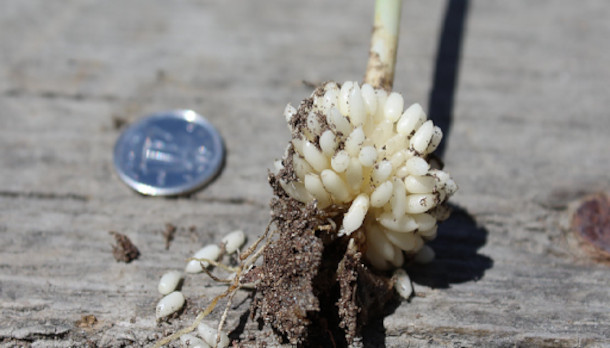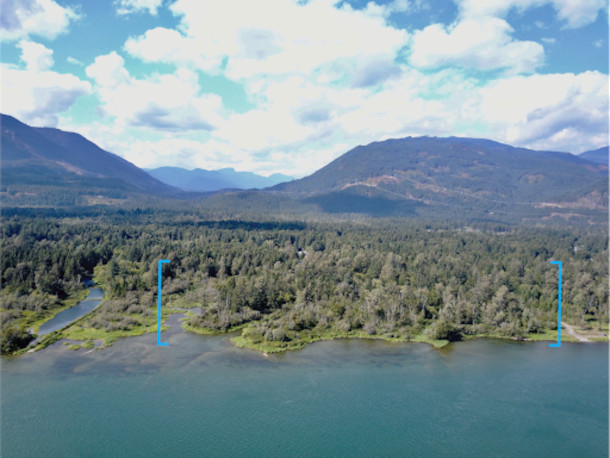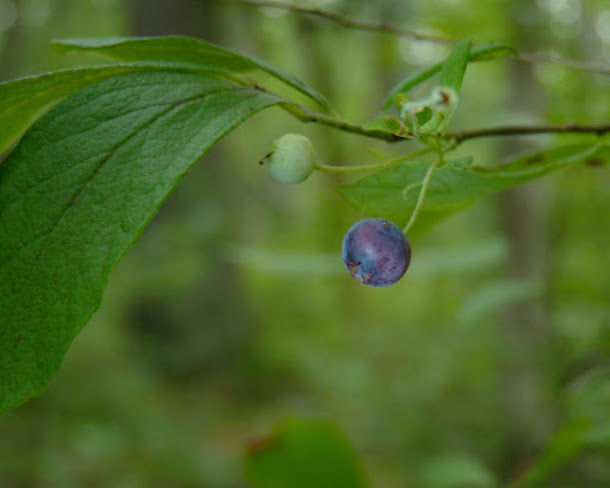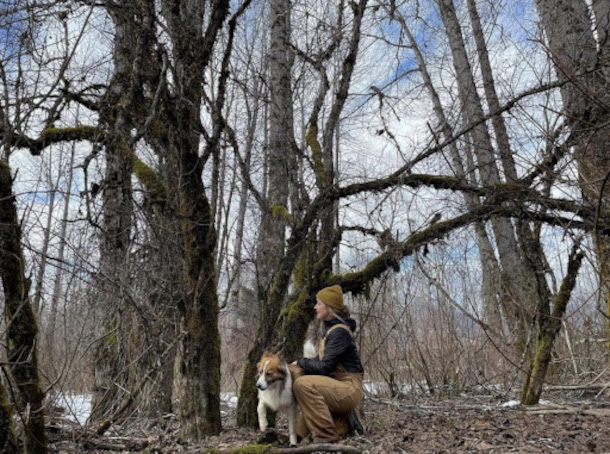First Nations Forest Gardens
Air Date: Week of July 23, 2021

“Wild rice,” also known as the Chocolate Lily (Fritillaria camschatcensis), has an edible bulb full of grain-like rootlets. It’s just one of the many edible and medicinal plants found in the “forest gardens” of the Pacific Northwest (Photo: Chelsey Geralda Armstrong)
The Pacific Northwest is known for its lush green conifers, but deep in special pockets of the forest, deciduous and fruit-bearing trees and plants create a mosaic of rich biodiversity. These “forest gardens”, cultivated by First Nations people for millennia, provide a wide array of foods and unique ecosystem functions. Dr. Chelsey Geralda Armstrong, an Assistant Professor of Indigenous Studies at Simon Fraser University, joins host Bobby Bascomb to discuss her work studying the historical ecology of forest gardens with communities in the Ts’msyen and Coast Salish territories of Northwestern British Columbia.
Transcript
BASCOMB: British Columbia is home to lush forests that cover almost two thirds of the Canadian province. And for some ten thousand years, First Nations peoples made the forests their home. The trees provided much of what the people needed to survive and thrive. After asking permission of towering cedars, Coast Salish and other peoples would harvest bark for weaving and wood to carve canoes and totem poles. But they also carved out special gardens in the forest to grow food and medicinal plants. And new research shows that these forest gardens are still home to abundant biodiversity, long after settler colonialism and government assimilation policies separated First Nations people from their homes. Chelsey Armstrong studies these forest gardens as a professor at Simon Fraser University and joins me from a research station near the Alaska panhandle.
ARMSTRONG: We live in the Pacific Northwest where you have very contiguous conifer dominant forests, right? Very, very rich in cedar and spruce and hemlock and firs. And yet these forest gardens stand out like a sore thumb. They're broadleaf forests, which are very rare here. So they're composed of a canopy of things like maple and birch and then sub canopies of hazelnut and crabapple, all deciduous species. One of the big things that kind of sticks out when you're in these places is at the right time of year, it's just like a fruit paradise. There's so many fruits going, kind of around late August, early September. It is an edible forest without question, and also a lot of medicinal species as well in that understory, things like wild ginger, but also root foods, things like wild rice, not the wild rice that you would see in the Great Lakes region, but Fritillaria camschatcensis, it's a lily plant, but it has an edible bulb with lots of little rootlets, which is a really important plant. Very, very different from what you would think when you imagine the iconic Northwest, and very unique in that sense.
BASCOMB: And these were gardens cultivated by the Indigenous people that lived there, how did they create them? It sounds like they must have had to travel quite far to bring these different species together in one spot.

An aerial shot of the Sts’ailes forest garden. These forests demonstrate the way that First Nations people in the Pacific Northwest, like Indigenous communities across the globe, have actively managed natural ecosystems to increase the accessibility and productivity of preferred food plants near their homes (Photo: Chelsey Geralda Armstrong)
ARMSTRONG: Well, so a lot of what we know about how these were created, how they were maintained, we use analogy, and from that I mean, the ethnographic record. So how elders talk about, for example, pruning different crabapple trees, or transplanting things like Saskatoon berry long distances. We don't know exactly how they were started, or when, how old they are, although we are getting closer to some dates. But you can imagine people that were new to an area would start by clearing it of any conifer trees, because again, in the Northwest, they're almost invasive. If you turn your back from a clearing, the conifer saplings will colonize pretty quickly. We know people were burning often, so it is possible that these areas were burned. And then yeah, as you mentioned, bringing certain plants in, we know that there are locally exotic species, so hazelnut, for example. It is a native species to British Columbia, but it's found far outside its range in certain forest gardens. But also, people were managing for succession. These types of forest management practices are basically utilizing and capitalizing on natural ecosystem processes. So things like wild raspberries, black huckleberries, Alaska blueberry, oval leaf blueberry, all these kinds of plants that grow in forest gardens are locally available. And so it's just about letting those things come back, keeping the competitors out, and then enhancing them with new species, like trees and shrubs like Pacific crabapple, or hazelnut, which we know were transplanted quite long distances.
BASCOMB: And how does the biodiversity and productivity of these forest gardens compare to the biodiversity that you'd expect to find in the conifer forest that surrounds them?
ARMSTRONG: Yeah, so our research looked at using a series of botanical inventories and comparing forest gardens with the surrounding conifer forests, or what we refer to as peripheral forest. It was very clear that overall, forest gardens are much more rich. You can count a lot more species, and they're represented evenly. And so we know that forest gardens are a lot more biodiverse. But capturing the nuance of diversity is really important too, when we look at biodiversity. And so it's not to say that forest gardens are necessarily better than conifer forests because they're more diverse. But when you break down the diversity by life form, we get a nice picture. So for example, tree diversity, more diverse in the conifer or periphery forests. When you look at shrub diversity, or herb diversity, there are more species and more diverse representation of those species in the forest gardens. And so you can imagine that, in fact, the edge between these two ecosystems are incredibly productive areas.

Indigenous gardens in the Pacific Northwest have been “managed for succession,” which means gardeners have actively cultivated naturally occurring species like these oval leaf blueberries (Vaccinium ovalifolium) by keeping competitors out. (Photo: Dendroica cerulea, Flickr, CC BY-NC-SA 2.0)
BASCOMB: Well, that totally makes sense. I mean, you would expect more biodiversity in an area with, say, maybe a field, next to a forest, with a river running through it. If you have several different ecosystems all in one spot, you would expect to find a lot of different plants and animals in that one spot as opposed to more, you know, a homogenous ecosystem.
ARMSTRONG: That's exactly right. And these forest gardens do provide this kind of patchwork mosaic that we see, again, breaking through that conifer dominant landscape. And so they are providing all sorts of different functions that you're talking about. And that was the second part of our study, was looking at, okay, we know that these gardens, these forest gardens are more rich, but what does that actually mean? And so ecologists look at something called functional diversity, and we use, or functional traits, to see okay, what are these ecosystem functions or what are the services that these forest gardens are providing? And what we found was that, as you say, these were great places for animals and pollinators. And we found that forest gardens have a higher frequency of animal dispersed and animal pollinated species. So what this means is that forest gardens are the result of animal movement. And of course, humans are included in that category. But on top of that, what this suggests is that after humans left these gardens and villages, in some cases a couple hundred years ago, forest gardens began providing really unique habitat for animals and pollinators seeking food. So what we see here is an example of human land use that actually provides and increases functions across the landscape, rather than depleting it. We always talk about human land use as being a negative thing, but this is a prime example of where land use over time actually is a good thing for all these critters and animals and things hanging out in the Northwest coast.
BASCOMB: Wow, it's just fascinating. Chelsey, can you tell me about the First Nations people that lived in this area and created these gardens?
ARMSTRONG: Yeah, so forest gardens spans pretty large area in the Pacific Northwest, but where we worked mostly, is in Ts’msyen territory in northwestern BC. And specifically, I worked with two communities, Kitsumkalum, and Kitselas. And, you know, the archaeological record of people living in this area is very, very rich, people have been here for, you know, 10,000 plus years. And for Kitselas, we know that they've been, a lot of families have been in the same canyon area for at least 7000 years, these are some of their hereditary names of ranked chiefs are some of the longest held titles in the world. So people have been here for a long time. And these forest gardens were probably managed for millennia, but as far as settler colonialism interrupting and, you know, violently suppressing a lot of these practices, that started around the mid 1800s. And so people were forcibly removed from their communities. A lot of times they moved to the coast to work in canneries, which were, you know, kind of slave-like conditions for people. But they returned, a lot of them, to their communities in the 50s and 60s. And so we see this kind of return of people to the forest garden areas. And as I said, they know about these places, we're catching up to it. One example, there's elders in Kitselas that always say, "old villages are really good places to hunt," right, kind of reifying what we know about the functional diversity of the area being great for animal habitat. But basically, these places have not been maintained for, you know, 200 years, but they're starting to again, and that's a huge part of our research is actually employing different management strategies, clearing the forest garden areas and getting them back to a place where they can be producing lots of food for people locally.

Dr. Chelsey Geralda Armstrong is an Assistant Professor of Indigenous Studies at Simon Fraser University. Her lab studies historical human-landscape interactions and their lasting impacts in the present day. Their current work is centered around the historical ecology of the global north and the traditional resource and environmental management of inhabited landscapes. (Photo: Courtesy of Chelsey Geralda Armstrong)
BASCOMB: And what did you learn about these forest gardens from the First Nation elders that you spoke with?
ARMSTRONG: Oh, I mean, everything. I began my research actually looking at the historical ecology and ethnobotany of hazelnut. And I was brought north by a colleague who said, Oh, we have lots of hazelnut at this archaeological site. And when I got there, it became very apparent that hazelnut was part of a larger modified ecosystem, these forest gardens. And the elders had pointed me in that direction, saying, well, it's not just hazelnut. It's this, you know, it's Pacific crabapple. It's Saskatoon berries, it's soapberries. And so, you know, they're the ones that were leading a lot of this inquiry. And of course, we know from them all the different ethnobotanical uses of plants. But also, they knew of other areas where this was occurring. So I was working at Dałk Gyilakyaw, which is the ancestral homeland of Kitsumkalum people, and a community member said, Well, if you think this is cool, you should go check out the Kitselas Canyon, the same thing is happening there. And so, go to the Kitselas Canyon, sure enough, it was another village complex with forest gardens. So I mean, really, we're, as researchers, we're using different scientific methods and scientific principles to better understand these places, but in a lot of ways, a lot of communities already know about these places. And so we're just enhancing those studies with our own ideologies. And a lot of our research is kind of being led by them and the questions that they have about these places that we can answer.
BASCOMB: Chelsey Armstrong directs the Historical and Ethnoecological Research, or HER, Lab at Simon Fraser University. Chelsey, thank you so much for joining me today.
ARMSTRONG: Yeah, it was such a pleasure. Thanks so much for having me.
Links
Learn more about Dr. Chelsey Geralda Armstrong
National Geographic |”'Forest Gardens’ Show How Native Land Stewardship Can Outdo Nature”
Science | “Pacific Northwest’s ‘Forest Gardens’ Were Deliberately Planted by Indigenous People”
Living on Earth wants to hear from you!
Living on Earth
62 Calef Highway, Suite 212
Lee, NH 03861
Telephone: 617-287-4121
E-mail: comments@loe.org
Newsletter [Click here]
Donate to Living on Earth!
Living on Earth is an independent media program and relies entirely on contributions from listeners and institutions supporting public service. Please donate now to preserve an independent environmental voice.
NewsletterLiving on Earth offers a weekly delivery of the show's rundown to your mailbox. Sign up for our newsletter today!
 Sailors For The Sea: Be the change you want to sea.
Sailors For The Sea: Be the change you want to sea.
 The Grantham Foundation for the Protection of the Environment: Committed to protecting and improving the health of the global environment.
The Grantham Foundation for the Protection of the Environment: Committed to protecting and improving the health of the global environment.
 Contribute to Living on Earth and receive, as our gift to you, an archival print of one of Mark Seth Lender's extraordinary wildlife photographs. Follow the link to see Mark's current collection of photographs.
Contribute to Living on Earth and receive, as our gift to you, an archival print of one of Mark Seth Lender's extraordinary wildlife photographs. Follow the link to see Mark's current collection of photographs.
 Buy a signed copy of Mark Seth Lender's book Smeagull the Seagull & support Living on Earth
Buy a signed copy of Mark Seth Lender's book Smeagull the Seagull & support Living on Earth

